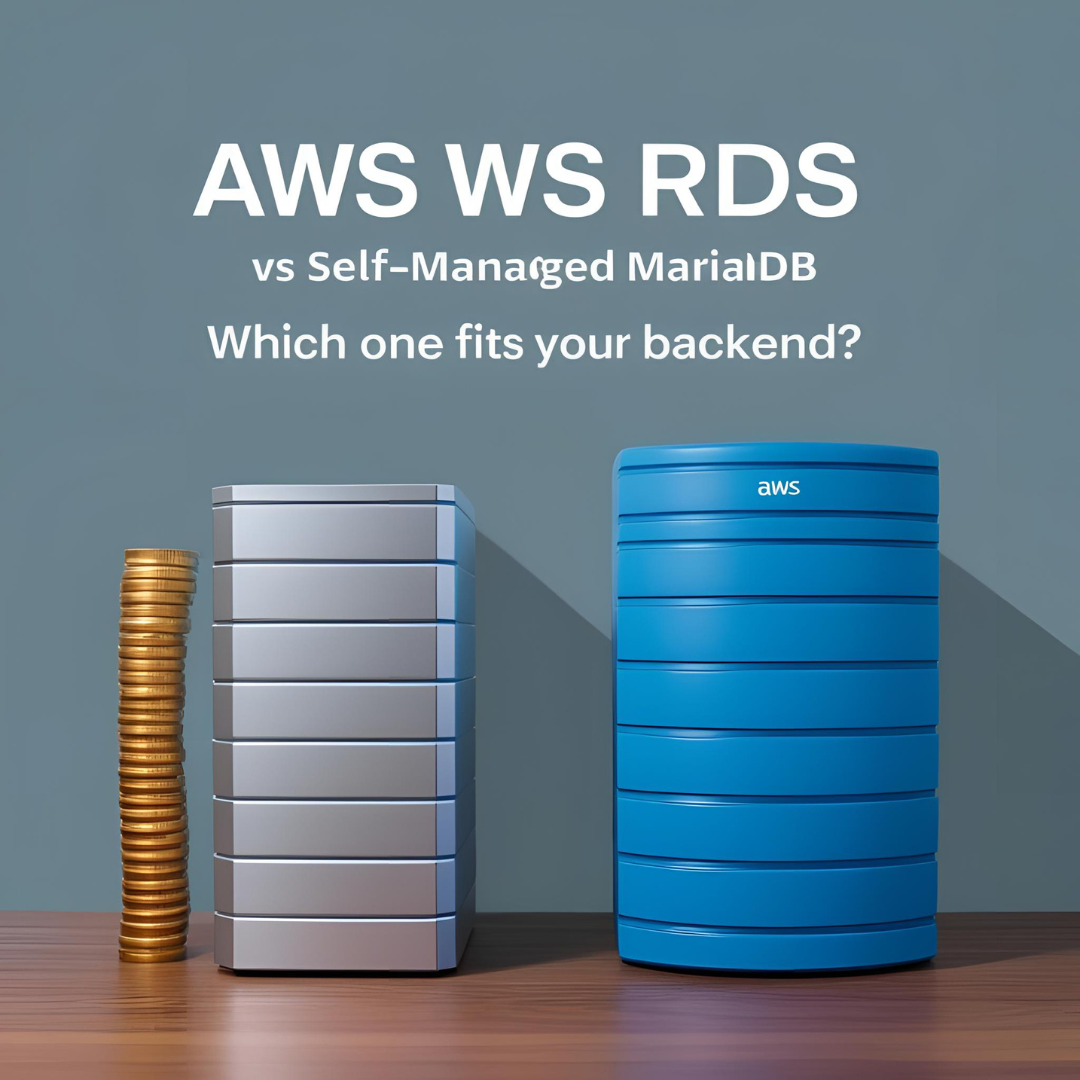Choosing the right database deployment strategy can significantly impact your application’s performance, reliability, and operational costs. This article compares two popular options for running MariaDB: Amazon’s Relational Database Service (RDS) and self-managed MariaDB deployments, helping you determine which approach best suits your specific backend requirements.
AWS RDS for MariaDB: Managed Database Service
Amazon RDS for MariaDB is a fully managed database service that handles routine database tasks like provisioning, patching, backups, recovery, and scaling.
Advantages of AWS RDS
1. Simplified Administration
RDS automates time-consuming administration tasks, allowing your team to focus on application development rather than database management.
"With RDS, we reduced our database administration overhead by approximately 70%, allowing our developers to focus on building features rather than managing infrastructure."
- Sarah Chen, CTO of a mid-sized SaaS company
2. Built-in High Availability
RDS offers Multi-AZ deployments that provide automatic failover to a standby replica in case of an outage, ensuring minimal downtime.
3. Automated Backups and Point-in-Time Recovery
RDS automatically backs up your database and transaction logs, enabling point-in-time recovery for up to 35 days.
4. Scalability Options
You can scale your database instance vertically (changing instance type) with minimal downtime and horizontally (using read replicas) to distribute read traffic.
5. Enhanced Security Features
RDS provides security features like VPC isolation, encryption at rest using AWS KMS, encryption in transit, and IAM authentication.
6. Monitoring and Metrics
Integration with CloudWatch provides comprehensive monitoring capabilities with pre-configured metrics and alarms.
Disadvantages of AWS RDS
1. Cost Considerations
RDS typically costs more than running equivalent EC2 instances for self-managed databases, especially at scale.
2. Limited Customization
You can’t access the underlying operating system or customize database configurations beyond what RDS parameters allow.
3. Version Constraints
There may be delays in the availability of the latest MariaDB versions on RDS.
4. Vendor Lock-in
Moving away from RDS requires careful planning and potential downtime.
Self-Managed MariaDB: Full Control and Flexibility
Self-managed MariaDB involves installing, configuring, and managing MariaDB on servers you control—whether on-premises, in colocation facilities, or on cloud VMs like EC2 instances.
Advantages of Self-Managed MariaDB
1. Complete Control
You have full access to the operating system, database configuration, and storage options.
2. Customization Capabilities
You can fine-tune every aspect of your database for specific workloads and requirements.
"Our specialized financial application requires custom database plugins and specific storage engine configurations that were only possible with a self-managed MariaDB deployment."
- Michael Rodriguez, Database Architect at a financial services firm
3. Potential Cost Savings
At large scale or with specialized hardware requirements, self-managed databases can be more cost-effective.
4. Latest Features
You can immediately adopt the latest MariaDB versions and features as they’re released.
5. No Vendor Lock-in
You maintain the flexibility to move your database between different environments and providers.
Disadvantages of Self-Managed MariaDB
1. Operational Responsibility
Your team is responsible for all aspects of database administration, including:
- Server provisioning and maintenance
- Database installation and configuration
- Backup and recovery procedures
- Performance tuning and optimization
- Security patches and version upgrades
2. High Availability Complexity
Implementing high availability features like replication, clustering, and automated failover requires significant expertise.
3. Scaling Challenges
Scaling a self-managed database often involves downtime and careful planning.
4. Security Implementation
You must design and implement all security measures yourself, including encryption, access controls, and audit logging.
Decision Framework: Which Option Is Right for You?
Choose AWS RDS if:
- You have limited database administration expertise
- You value operational simplicity over complete control
- Your application requirements fit within RDS parameters
- You need rapid deployment with minimal setup time
- You prefer predictable operational costs over upfront investments
- You want integrated monitoring and management within AWS
Choose Self-Managed MariaDB if:
- You need full control over the database environment
- You require extensive customization beyond RDS parameters
- You have specialized performance or configuration requirements
- You have experienced database administrators on staff
- You’re concerned about vendor lock-in
- Cost optimization at scale is a primary concern
- You need to use features or versions not yet available in RDS
Cost Comparison Example
Let’s compare the monthly costs for a production-grade database setup:
AWS RDS for MariaDB (Multi-AZ, db.r6g.2xlarge)
- Instance cost: ~$760/month
- Storage (500GB gp3): ~$115/month
- Backup storage (assuming 100% of DB size): ~$23/month
- Total: ~$898/month
Self-Managed MariaDB on EC2
- 2 x r6g.2xlarge EC2 instances (for HA): ~$560/month
- EBS storage (500GB gp3 x 2): ~$230/month
- Backup storage to S3: ~$11.50/month
- Total: ~$801.50/month
While the self-managed option appears less expensive, this calculation doesn’t account for the personnel costs of database administration, which can be substantial.
Real-World Deployment Scenarios
Scenario 1: E-commerce Startup
A growing e-commerce startup with limited technical staff and moderate traffic would benefit from RDS’s simplicity and automated management, allowing their small team to focus on building the application rather than managing databases.
Scenario 2: Enterprise Financial System
A financial institution with specialized compliance requirements and a team of experienced DBAs might prefer self-managed MariaDB for the control it provides over security configurations, custom plugins, and specific optimization techniques.
Scenario 3: SaaS Application
A SaaS company might use a hybrid approach—RDS for their production environment to benefit from high availability and automated backups, while using self-managed MariaDB instances for development and testing to reduce costs.
Conclusion
The choice between AWS RDS and self-managed MariaDB ultimately depends on your specific requirements, resources, and priorities:
- AWS RDS excels in simplicity, reliability, and reducing operational overhead at the cost of some flexibility and potentially higher direct expenses.
- Self-managed MariaDB provides maximum control and customization but requires significant expertise and takes responsibility for all operational aspects.
Many organizations start with RDS to benefit from its simplicity and then evaluate whether the additional control of self-managed MariaDB justifies the increased administrative overhead as their needs evolve.
When making your decision, consider not just the current state of your application but also your growth trajectory, team capabilities, and long-term strategic goals.


Leave a Reply